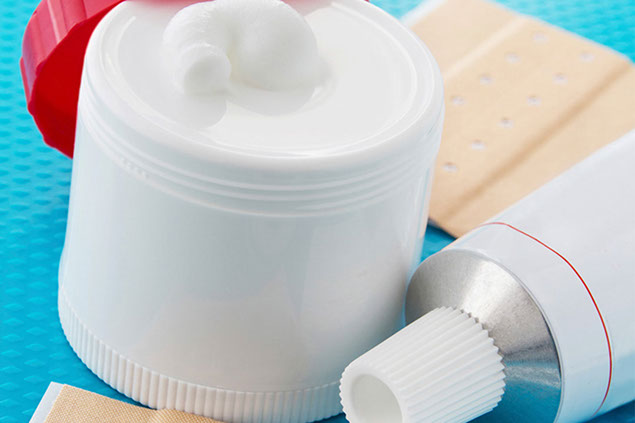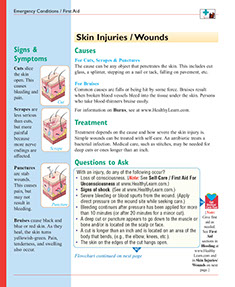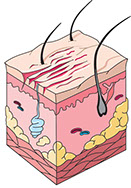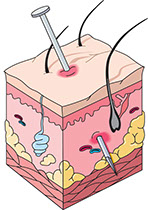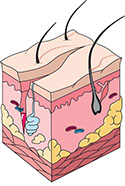CONDITIONS
SYMPTOM CHECKER
Male
Female
Child
Arm, Hand & Shoulder Concerns
Legs & Feet Concerns
Dental & Mouth Concerns
Ear & Nose
Eye Conditions
Head Conditions
Arm, Hand & Shoulder Concerns
Legs & Feet Concerns
Front
Back
Arm, Hand & Shoulder Concerns
Dental & Mouth Concerns
Ear & Nose
Eye Conditions
Head Conditions
Arm, Hand & Shoulder Concerns
Dental & Mouth Concerns
Ear & Nose
Eye Conditions
Head Conditions
Front
Back
Arm, Hand & Shoulder Concerns
Neck Links
Head & Neck Concerns
Arm, Hand & Shoulder Concerns
Neck Links
Head & Neck Concerns
Front
Back
Online Clinic
Wise Healthcare
Skin Injuries / Wounds
Print on Demand
RELATED ARTICLES
Signs & Symptoms
Cuts slice the skin open. This causes bleeding and pain.
Scrapes are less serious than cuts, but more painful because more nerve endings are affected.
Punctures are stab wounds. This causes pain, but may not result in bleeding.
Bruises cause black and blue or red skin. As they heal, the skin turns yellowish-green. Pain, tenderness, and swelling also occur.
Causes
For Cuts, Scrapes & Punctures
The cause can be any object that penetrates the skin. This includes cut glass, a splinter, stepping on a nail or tack, falling on pavement, etc.
For Bruises
Common causes are falls or being hit by some force. Bruises result when broken blood vessels bleed into the tissue under the skin. Persons who take blood-thinners bruise easily.
Treatment
Treatment depends on the cause and how severe the skin injury is. Simple wounds can be treated with self-care. An antibiotic treats a bacterial infection. Medical care, such as stitches, may be needed for deep cuts or ones longer than an inch.
Questions to Ask
Question 1
With an injury, do any of the following occur?
• Loss of consciousness. Signs of shock. Severe bleeding or blood spurts from the wound. Bleeding continues after pressure has been applied for more than 10 minutes (or after 20 minutes for a minor cut).
• A deep cut or puncture appears to go down to the muscle or bone and/or is located on the scalp or face. A cut is longer than an inch and is located on an area of the body that bends, (e.g., the elbow, knees, etc.). The skin on the edges of the cut hangs open.
Get medical care without delay. If symptoms are life threatening go to the ER or call 9-1-1. Don’t call 9-1-1 or use the ER if symptoms do not threaten life. Ask your doctor ahead of time where you should go for a problem that needs prompt care, but not emergency care.
Question 2
Does any sign of infection occur?
• Fever and/or general ill feeling.
• Redness. Or, red streaks extend from the wound site.
• Increased swelling, pain, or tenderness at or around the wound.
You should be seen by your doctor for medical advice. Contact your doctor or health care provider to find out how soon you should be seen.
Question 3
Was the cut or puncture from dirty objects, rusty nails, or objects in the soil? Or, did a puncture go through a shoe, especially a rubber-soled one?
You should be seen by your doctor for medical advice. Contact your doctor or health care provider to find out how soon you should be seen.
Question 4
Do you have any of these problems?
• Bruises appear often and easily, take longer than 2 weeks to heal, or occur more than 3 times a year for no known reason.
• Vision problems occur with a bruise near the eye.
You should be seen by your doctor for medical advice. Contact your doctor or health care provider to find out how soon you should be seen.
Use Self-Care / First Aid:
You can probably take care of the problem yourself if you answered NO to all the questions. Use the “Self-Care” measures that are listed. Call your doctor if you don’t feel better soon, though. You may have some other problem.
Self-Care / First Aid
For Minor Cuts and Scrapes
• Clean in and around the wound thoroughly with soap and water.
• Press on the cut for up to 10 minutes to stop the bleeding. Use sterile, wet gauze or a clean cloth. Dry gauze can stick to the wound. Don’t use a bandage to apply pressure.
• If still bleeding, lift the part of the body with the cut higher than the heart, if practical.
• After the bleeding has stopped and when the area is clean and dry, apply a first-aid cream.
• Put one or more bandages on the cut. The edges of the cut skin should touch, but not overlap. Use a butterfly bandage if you have one.
• Keep a scrape clean and dry. Dress it with gauze and first-aid tape. Change this every 24 hours.
For Punctures that Cause Minor Bleeding
• Let the wound bleed to cleanse itself.
• Remove the object (e.g., splinter). Use clean tweezers. Hold a lit match or flame to the ends of the tweezers to sterilize them. Let them cool and wipe the ends with sterile gauze.
• Two to 4 times a day, clean the wound area with soapy water. Dry it well and apply an antibacterial cream. Do this for several days.
For Bruises
• Apply a cold pack to the bruised area as soon as possible (within 15 minutes of the injury). Keep the cold pack on for 10 minutes at a time. Apply pressure to the cold pack. Take it off for 30 to 60 minutes. Repeat several times for 2 days.
• Rest the bruised area and raise it above the level of the heart, if practical.
• Two days after the injury, use warm compresses for 20 minutes at a time.
• Do not bandage a bruise. Try to avoid hitting the bruised area again.
This website is not meant to substitute for expert medical advice or treatment. Follow your doctor’s or health care provider’s advice if it differs from what is given in this guide.
The American Institute for Preventive Medicine (AIPM) is not responsible for the availability or content of external sites, nor does AIPM endorse them. Also, it is the responsibility of the user to examine the copyright and licensing restrictions of external pages and to secure all necessary permission.
The content on this website is proprietary. You may not modify, copy, reproduce, republish, upload, post, transmit, or distribute, in any manner, the material on the website without the written permission of AIPM.
2021 © American Institute for Preventive Medicine - All Rights Reserved. Disclaimer | www.HealthyLife.com






